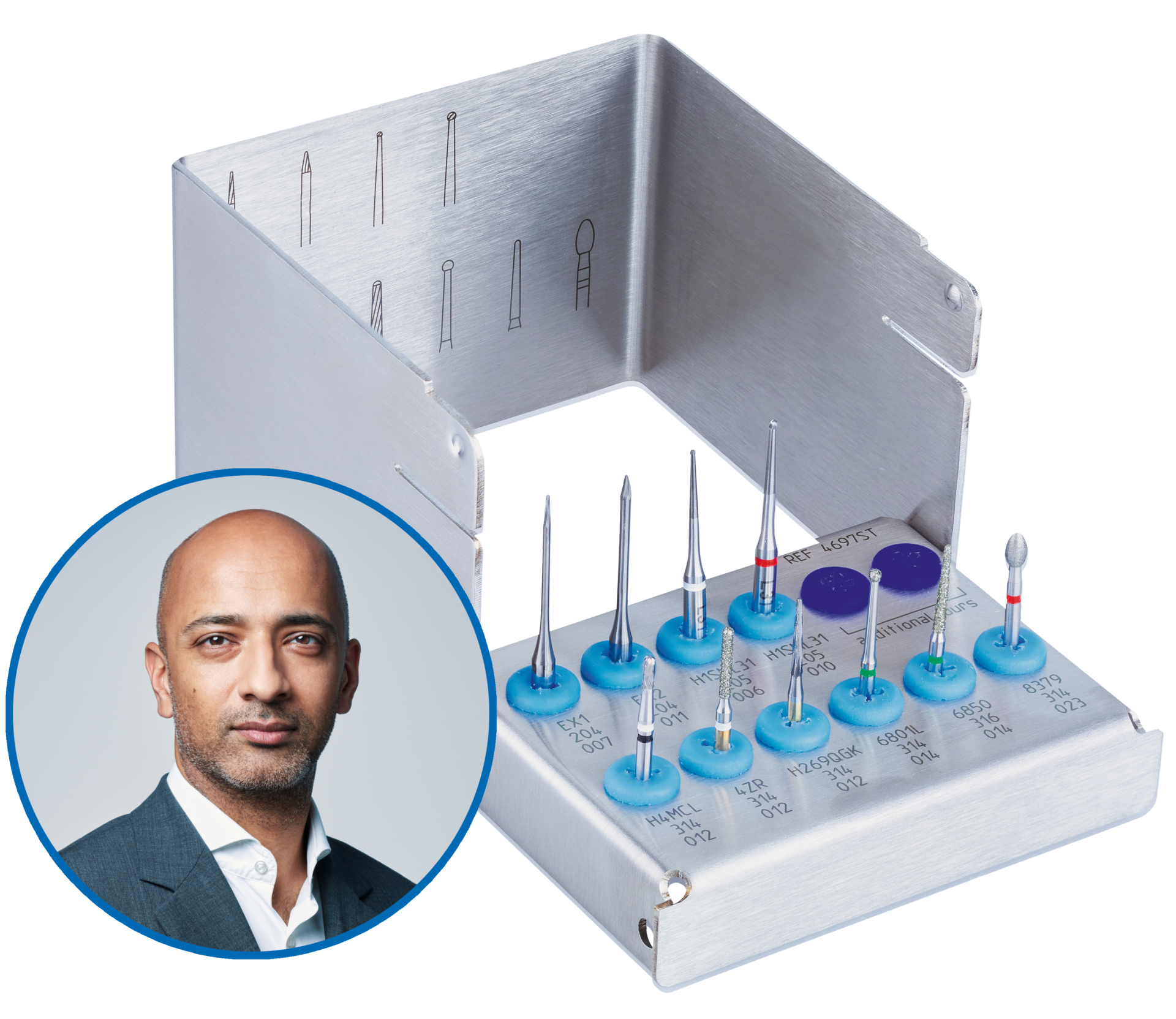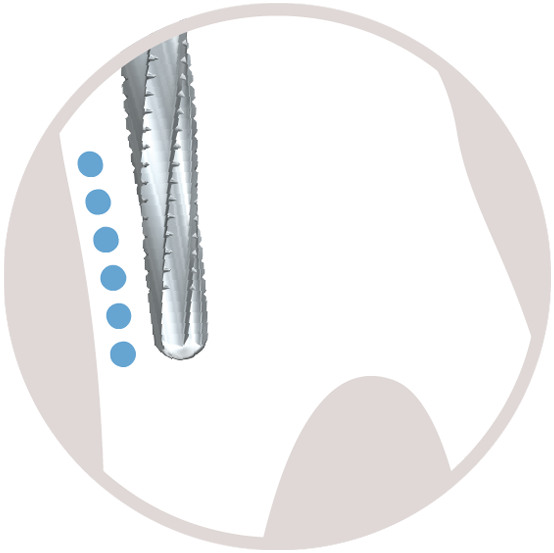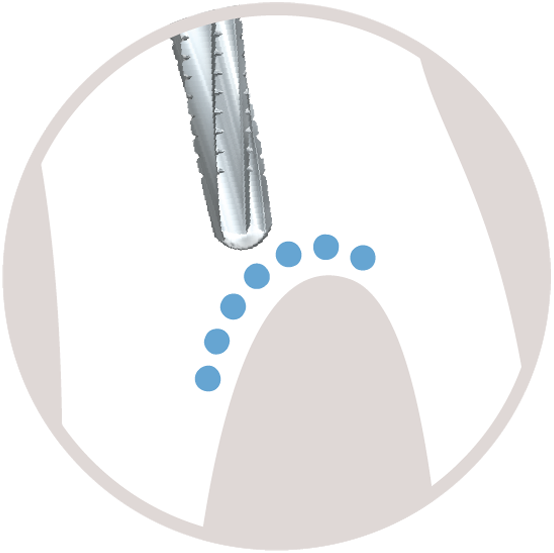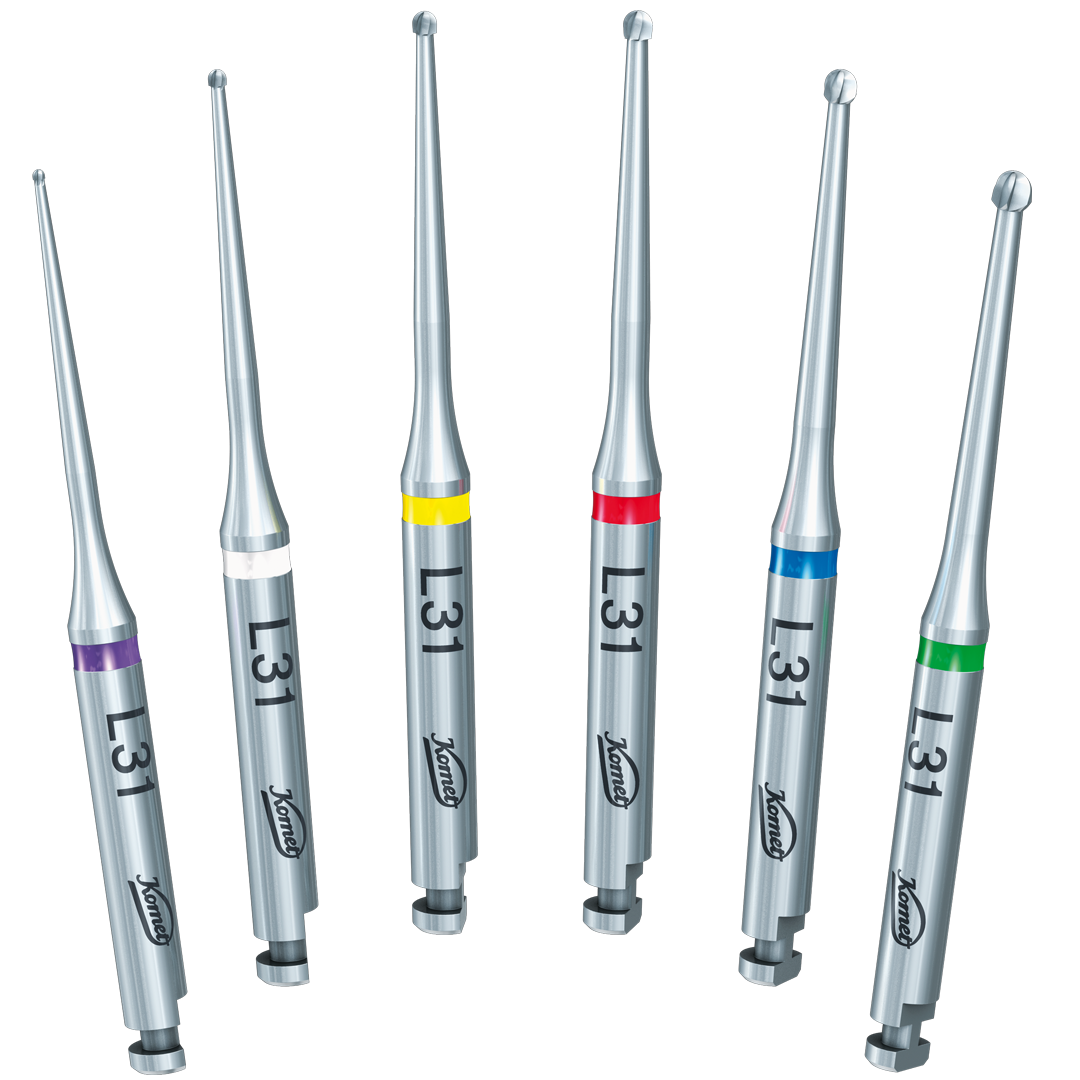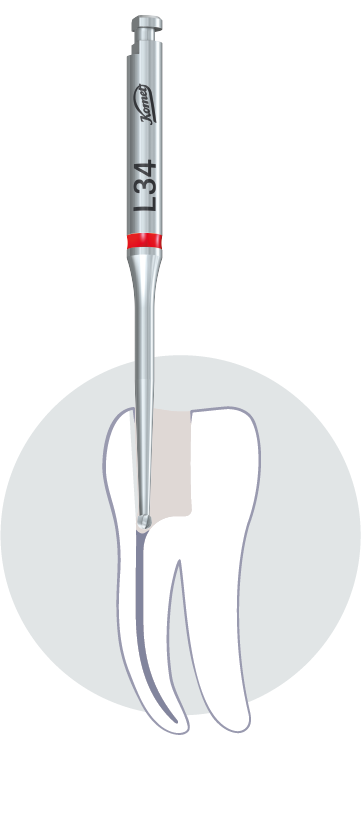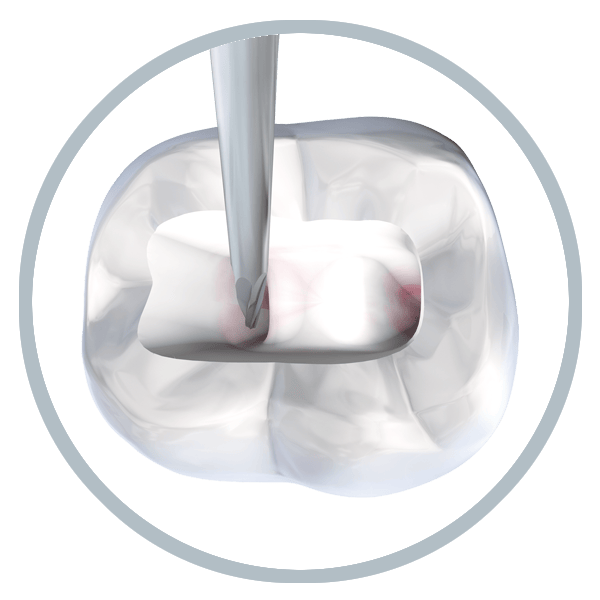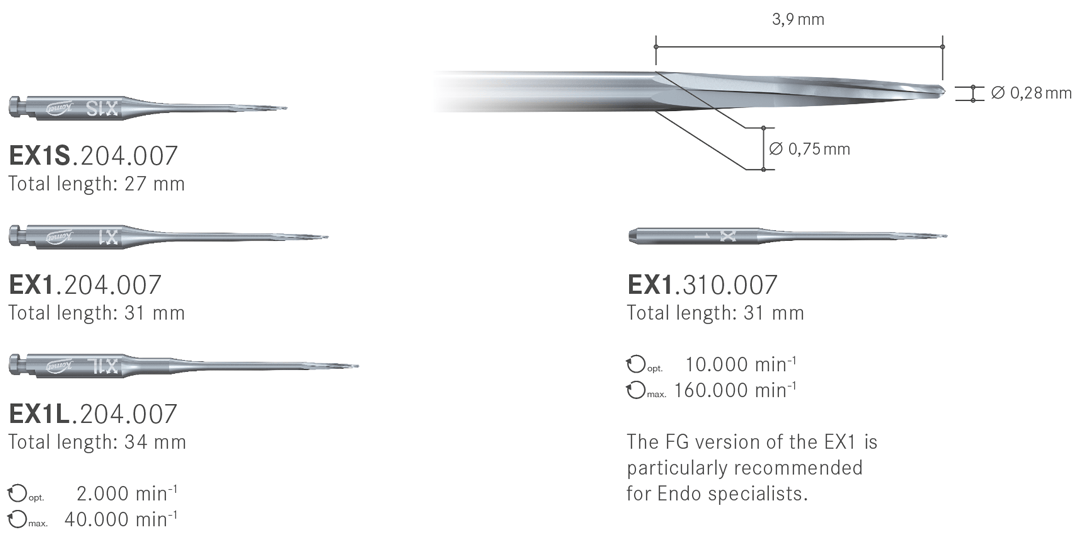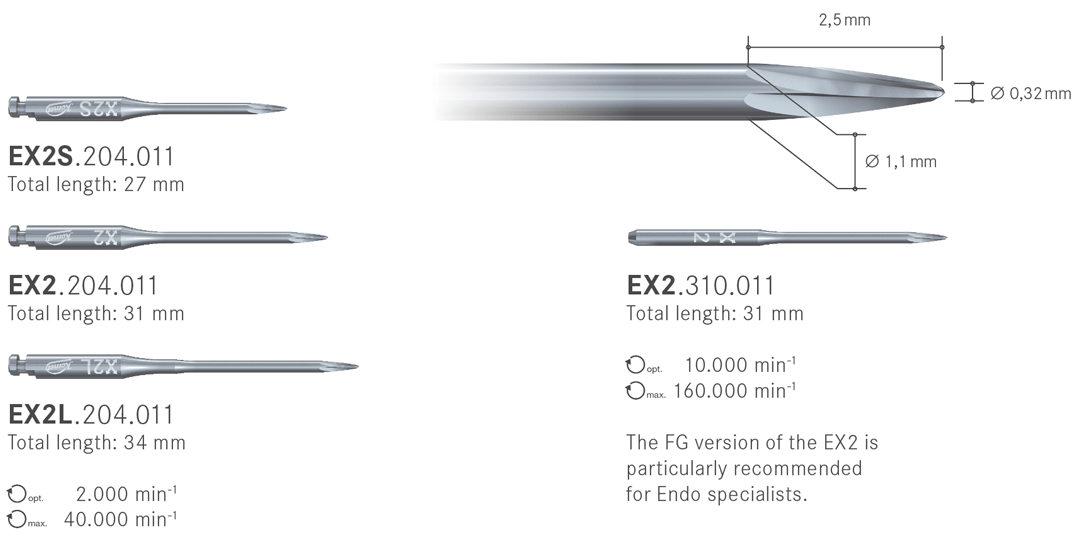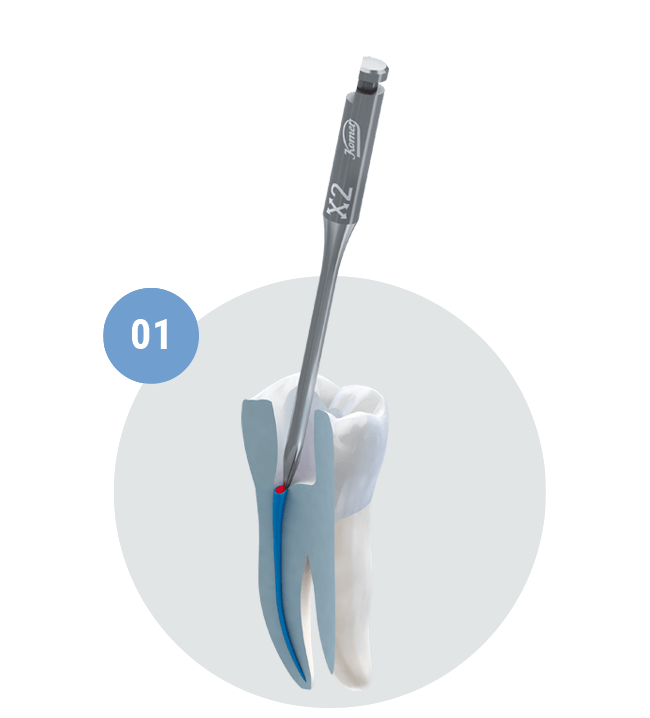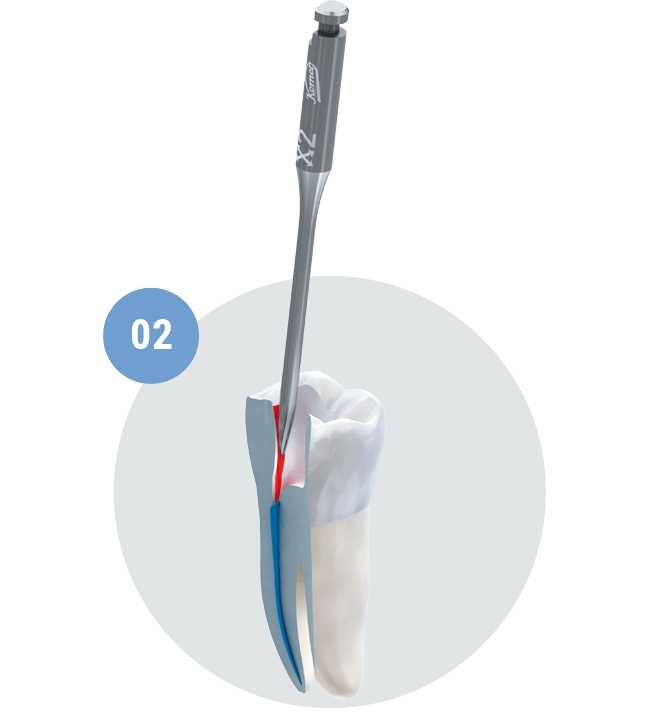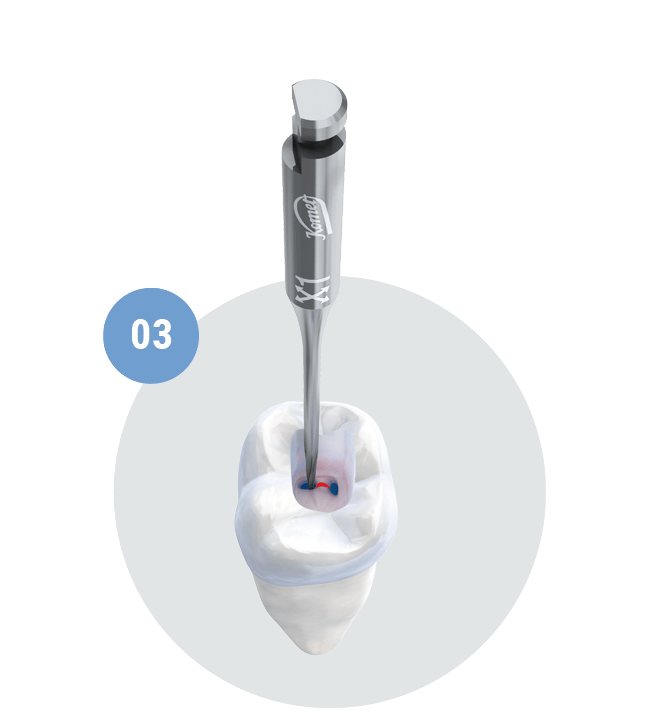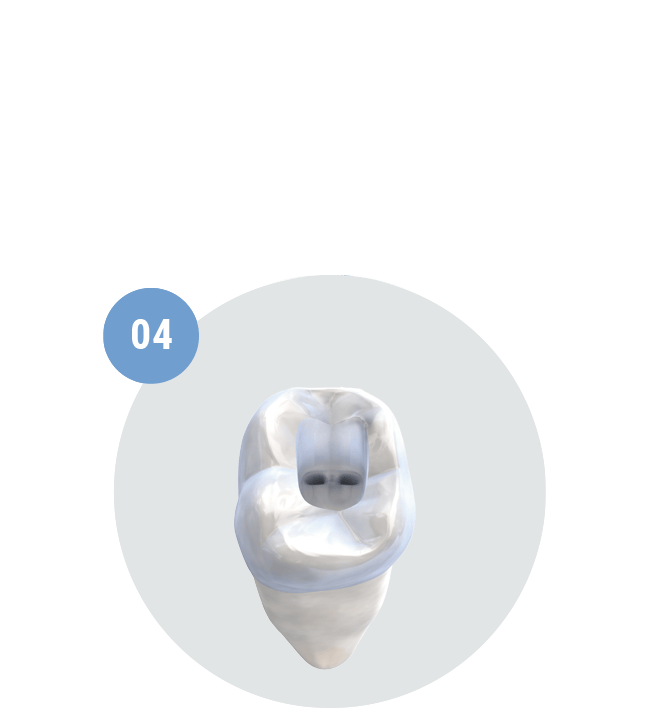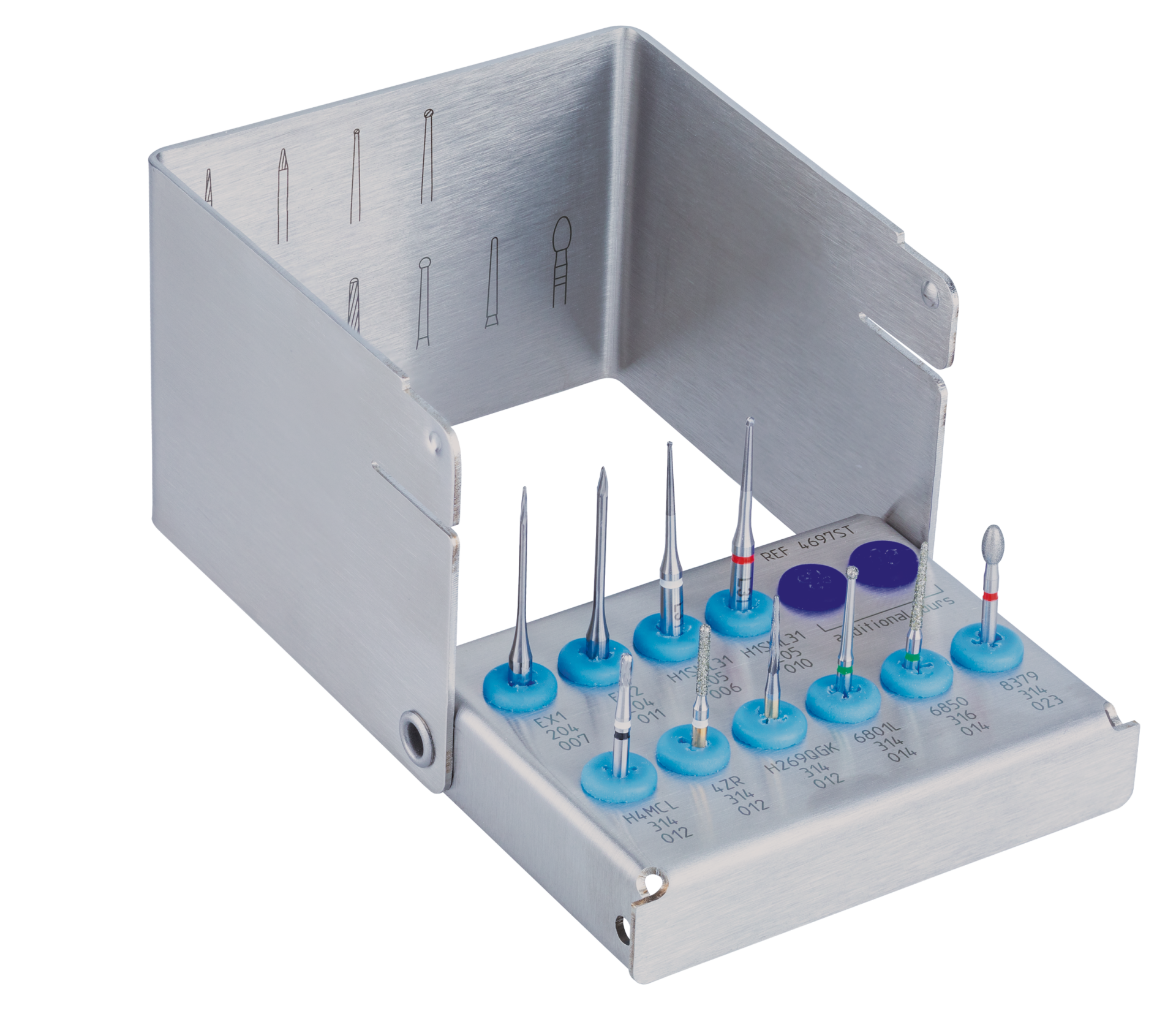Access Cavity
The creation of a perfect access cavity is the first step of any endodontic treatment. In many cases, this is more complicated than the subsequent preparation of the root canal. The formation of the access cavity is divided into two stages: the preparation of the primary cavity (access to pulp chamber) and the secondary cavity (access to the root canal system). The success of the endodontic treatment largely depends on these two vital first steps – the creation of sufficient space and unobstructed vision. Komet offers a comprehensive range of special instruments for this.
The EndoGuard.
Perfect view and safety.
With the EndoGuard, the course is set for success right from the start of the endodontic treatment. The creation of a perfect access cavity is the foundation of any successful endodontic treatment, which is why this phase often takes more time and effort than the subsequent preparation of the root canal.
Used immediately after opening the pulp chamber, the EndoGuard made by Komet helps to carry out this step with optimum efficiency and in perfect safety.
The course is set for Endo success. Your Advantages
Perfect access cavity
After the initial opening of the pulp chamber, the view of the cavity is improved and the discovery of the root canal orifices is facilitated by removing any dentin overhangs. The straight line access to the root canal system minimizes the risk of inadvertent canal transportation and fracture of the file.
Protection of the pulp chamber floor
The EndoGuard is provided with a safe, non-cutting tip to protect the floor of the pulp chamber and to avoid excessive removal of hard dental substance.
No preparation of undercuts
Thanks to the tapered shape of the EndoGuard, the preparation of undercuts is avoided as far as possible, thereby ensuring that no infected tissue is left behind in the pulp chamber.
Efficient cross-cut toothing
Thanks to its cross-cut toothing, the EndoGuard allows particularly efficient, yet smooth work. Complete control of the instrument is therefore guaranteed at all times.
The straight line access to the root canal system is the foundation of any safe and successful endodontic treatment.
While the overhangs in the distal obstruct the vision, the EndoGuard has created an excellent view of the mesial root canals.
The EndoTracer.
For accurate retrieval of all canals.
The EndoTracer is a special instrument intended for the preparation of isthmuses. The root canals of multi-rooted teeth tend to be difficult to locate, which means that they cannot alway be exposed and penetrated instantly as part of an endodontic treatment. In many cases, an isthmus has to be created along the entire length – or at least part of it – in order to locate a hidden canal.
The EndoTracer is provided with long slim neck to allow unobstructed view past the instrument into the access cavity. Like that, the dentist can look right down into the deeper regions of the cavity, which greatly facilitates the exposure of the pulp chamber floor, the conservative opening of the root canal entrances and the exposure of obliterated root canals.
The EndoTracer. Your Advantages.
Minimally invasive approach
Thanks to their special design, the petite round burs – especially the size 004 and 006 – are ideally suitable for the fine shaping of isthmuses and canal entrances, in line with the concept of minimally invasive endodontics.
Ideal for work under a microscope
The particularly long, slender neck of the instrument allows unobstructed view past the instrument into the access cavity. Provide with a total lenght of 34 mm, the design of the EndoTracer was adapted in such a way that its neck has now gained 3 mm in length, which makes the instrument been more suitable for work under a microscope. The properties of the EndoTracer L34 are particularly advantageous when it comes to treating long clinical crowns.
The perfect size for any tooth
The EndoTracer comes in the lengths 31mm and 34mm and in 6 different sizes, i.e. 004, 006, 008, 010, 012 and 014. This means that the range comprises a perfect instrument for any clinical situation.
Efficient toothing
The EndoTracers are provided with an effective, powerful toothing. Like that, the instruments can remove dentin the minimally invasive way and expose the access cavity practically without pressure.
The EndoExplorer.
It puts You Way Ahead.
In the last few years, dental medicine – and endodontics in particular – have experienced a shift in paradigm towards minimally invasive treatments. The conversative creation of access cavities and small trepan openings allow maximum conversative of healthy dental substance. The chance of long-term success of endodontic treatment is greatly increased by minimizing the risk of tooth and root fracture.
The instruments of the EndoExplorer are not only in step with the spirit of the times, they also set new benchmarks. Perfectly designed to suit the needs of microscope users, the innovative design of these instruments allows minimally invasive, perfectly controlled work during the creation of an endodontic access cavity.
In step with the spirit of the times – and beyond. Your Advantages.
A perfect view
The instrument design of the EndoExplorer is oprtimally adapted to the requirements of dentists that work with a microscope. The petite shape of the instrument head and its long, slim neck provide an unobstructed view of the site under microscope with up to 20 x magnification.
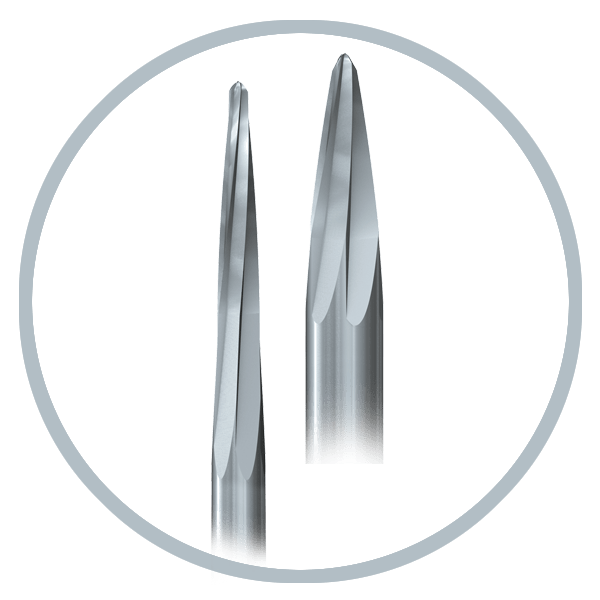
Less pressure, more efficienty
The instruments of the EndoExplorer set are provide with a sharp, fast-cutting toothing. Like this, the dentist can remove substance almost entirely without pressure whilst efficiently shaping the access cavity.
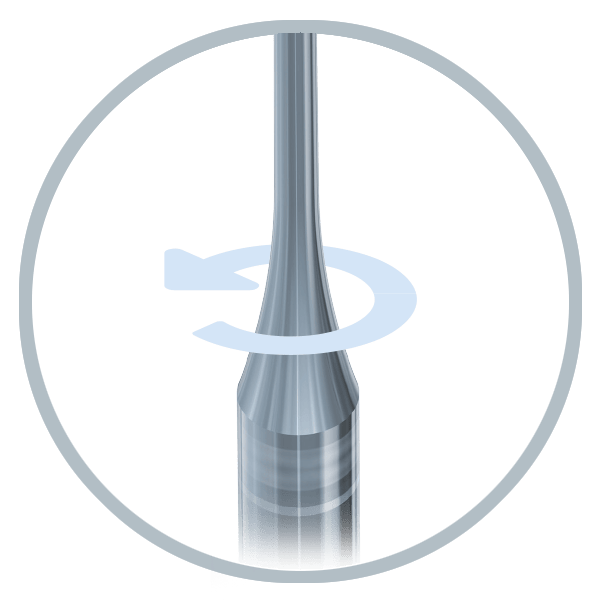
Concentric runout
The instruments contained in the EndoExplorer range are made entirely out of tungsten carbide. This ensures maximum runout accuracy even after several uses and guarantees precise work under prefect control.
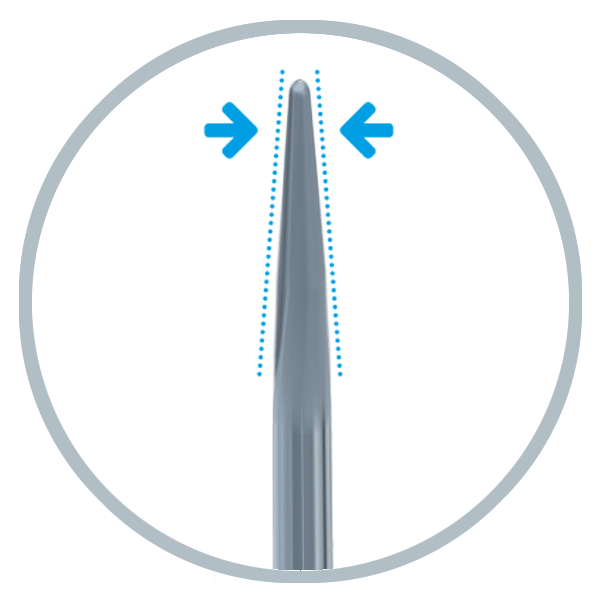
A new approach
The tapered head of the EndoExplorer instruments facilities controlled guidance of the instruments, thereby combining the precise removal of hard dental substance with the conservation of precious cervical dentin. This minimally invasive approach improves the long-term prognosis of teeth after an endodontic treatment.
The call for “Minimally invasive endodontic” is on everyone’s lips, but people often fail to see that this is not a revolutionary new demand. The desire to maintain as much dental substance as possible has always been considered one of the most important goals in sophisticated dentistry, but until now, there was no way of reliably putting this principle into practice. Help comes in the shape of the new EndoExplorer. In combination with H1SML round burs and appropriate visual aids, these instruments allow the dentist to create the required endodontic access whilst saving as much substance as possible, true to the motto: “as little as possible, as much as necessary”. What’s more, the use of the subsequently used root canal instruments is neither limited nor jeopardized. Both types have gained a firm place in our Endo Workflow and have become an invaluable part of our daily work.
The EndoExplorer System Overview
Indication of the EX1:
- Exposure of the anatomy of the pulp chamber floor
- Conservative opening of the root canal entrances
- Exposure of obliterated root canals
- Exposure of post and instrument fragments
Step by step.
Endo Access Kit 4697ST
by Shanon Patel.
A well-executed access cavity is the first and most important step of endodontic treatment. Locating all the canal entrances for subsequent preparation with minimal removal of sound dentine will improve the longevity of endodontically treated teeth.
There is no standardised access cavity design – the cavity preparation depends on several factors including the extent of dental caries, removal of defective restorations and negotiating calcifications as well as exploring crack lines.
Content of Kit 4697ST.
The Endo Access Kit consists of a pragmatic set of burs for both general dentists as well as Endodontists to prepare access cavities. Their long shank burs and precision cutting tips improve vision and allow controlled, rapid removal of tooth tissue, respectively.
A novel feature of this kit includes the space to add additional bur(s), thus allowing the clinician to personalise the Endo Access Kit for their use. In addition, the reference numbers and silhouette of the burs on the bur block allow easy ordering and organisation.
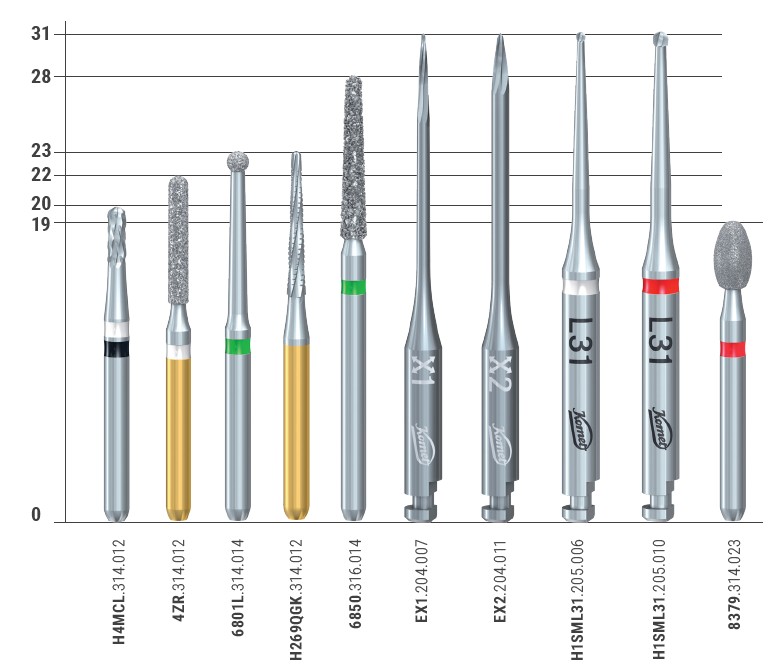
Step by Step. Access Cavity Preparation.
The aim of a pragmatically prepared access cavity is to provide access into the canal entrances whilst maintaining sound tooth structure. Each access cavity is unique and dictated by the nature of the patient’s tooth pulp chamber, position of the canal entrances and accessibility.
- Magnification and illumination are essential.
- Use recent periapical radiographs, and when indicated a CBCT scan to assess the anatomy of pulp chamber, degree of calcification and location of the canal entrances. Appreciate the distance from the occlusal aspect to the pulp chamber floor to avoid perforation.
- Remove the existing restoration, if there are signs of secondary caries, questionable restorability and/or potential evidence of cracks.
- The pulp chamber lies in the centre of the tooth at the cemento-enamel junction (CEJ) level. Probe around the CEJ circumference and orient the bur along the tooth’s long axis of the tooth, directed towards the centre of the CEJ (Law of Centrality).
- The borders of the access cavity will follow the external surface at the CEJ level (Law of Concentricity).
- Refine and/or remove dentine overhangs to ensure smooth, straight-line access into root canal entrances to minimise iatrogenic errors.
- The canal entrances are located at the junction of the floor and walls of the access cavity.
- Identify dark developmental lines (dentine map) on the floor of the pulp chamber, the canal entrances are located at the end of these lines.
- Excluding maxillary molars, the canal entrances are equidistant from/lie on an imaginary central line drawn in a mesial-distal direction through the pulp chamber floor (Law of Symmetry 1).
- The floor of the pulp chamber is darker than the access cavity walls.


Professor Shanon Patel
BDS, MSc, MClinDent, MRD, PhD, FDS, FHEA
Professor of Endodontology at King’s College, Consultant Endodontist at Guy’s & St Thomas’ NHS Trust, Specialist Practice, London, UK
Shanon divides his time between working in an interdisciplinary specialist practice and King’s College London teaching and carrying out clinical research.
His main research interests are management of longitudinal fractures, root resorption and treatment outcomes. He has supervised 80+ master’s and PhD students.
Shanon’s background as a clinical academic has resulted in him publishing over 140 papers. He is recognized internationally as a
leading authority on 3D (CBCT) imaging and root resorption and was lead author of 4 European Society of Endodontology position statements (CBCT 2014, 2019 and External Cervical Resorption 2018, Root resorption 2023).
Shanon has been invited as a keynote or plenary speaker at over 150 international meetings spanning 5 continents and has co-authored 7 textbooks which have been translated into 5 different languages.
References
Krasner P, Rankow HJ. Anatomy of the pulp chamber floor. Journal of Endodontics, 2004; 30(1):5. Patel S. Access cavity preparation in Pitt Ford’s Problem-Based Learning in Endodontics 2nd Edition, editors Perry E, Patel S, Kanagasingam S, Hamer S , 2024, Wiley Blackwell.



